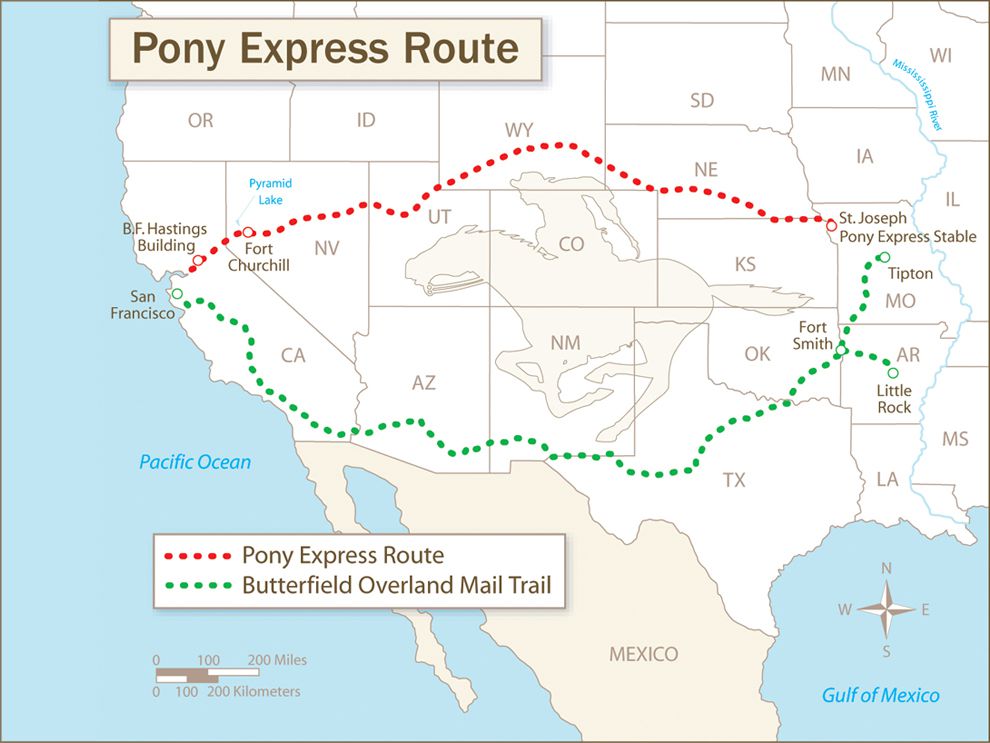TL;DR -- American stories can be real and interesting; most major themes are universal and apply across the scope of humanity. So, what's special? People, for one. Memorial Day is a time to reflect on that. Too, how things changed over the 400 years of the history starting with New England. The Pony Express is an example that happened right before the Civil War. It took several decades for the need to regular communication between the east coast and its leftie counterpart to come about. A way was developed for people to go from St. Louis to San Francisco. Arduously so. It took weeks. But, there were passengers. Meanwhile, in the north, young men went by horseback across the country in 10 days. That is, from St. Joseph MO to CA. Mind you, at that point, you are still a long way from the east coast. The Civil War disturbed the southern route which went north and displaced the Pony Express. We can follow their paths by car. In the south, ruts still exist from the coach traffic. The telegraph came in and changed things. Too though, post the Civil War, the U.S. finally got a transcontinental railroad establishd.
---
This post has several themes. One of them is technology on which we have had several posts, including a separate blog. The other deals with Memorial Day; our post, from 2021 looked at posts from 2020 and 2019. The Holiday, originally, had a focus on war casualties and changed to be more reflective, as a whole. Then, per usual, we look at people, mostly with a New England focus (Cape Ann, Essex County, and Massachusetts).
Starting with the ponies and riders, we can use Bill Cody (Wikipedia, WikiTree) of western fame as an example rider. His family had gone west out of the New England. Skipping over some details, we know that his father was an abolitionist which brought turmoil into the lives of his family. After his father's death, Bill found work that led to being involved with the Pony Express.
There is a lot of material on the subject, but this site (Riders of the Pony Express) has more details about riders than we see most places. Bill Cody was the most known. Many of these fellows did not have progeny and are forgotten. Some are mentioned on WikiTree without any details. At some point, perhaps, research will be done to fill in the missing pieces about the people.
Lots is known of the geography and technology. The National Park Service offers interpretative guides for auto tours (self-guided).
There were two technologies that interfered with the success of Pony Express. One dealt with regular coach traffic using horses which we discuss next. Then, there was the telegraph which could not carry mail but could relay information coast to coast, albeit not in today's quick mode.
 |
| Two routes of mail |
Earlier, we mentioned a route from San Antonia TX to San Diego CA that was quite successful. We also looked at one New England family (Giddings, of Ipswich MA) that was involved. Later, this route was part of a route from St Louis MO to San Francisco CA. In the above graphic, this is the route depicted by the blue dots. The Butterfield approach was quite successful even with the difficulties of travel. But, the start of the Civil War threw in a few troubles.
Texas closed their border to Butterfield access which interrupted the flow. Too, there was the contract by the U.S. Postal Service to deliver mail from the east coast to the west. The Butterfield line was doing fine with this and did not conflict with the northern delivery by the Pony Express. But, with inhibition of travel, a northern approach became necessary.
Some had already been trying to take coaches along the same route of the ponies. The new requirements got that going regularly, so that the Central Overland route was established. With this method in process, the Pony Express saw a serious decline in its business. At the same time, there was the coming railroad which was several years away from completion.
What did finally come about was the 1st Transcontinental Telegraph. It had started on the west coast and was coming east. As the gap was filled, the Pony Express had shortened routes to run which would be from the end of the eastern line to where the western line was in place. Once the telegraph became possible, the Pony Express ceased to be.
However, the Overland approach? The railroad was completed toward the start of the 1870s. It replaced the transcontinental coach route, though regional coach routes continued into the mid-part of the 20th century.
In this example, we see succeeding introduction of technology that replaces the former. Not abruptly, but gradually. That became easily seen and is part of life as we know it. The latest manifestation might be the slow adoption of the internet's ways until COVID forced normal ways to become either too hard or not capable at all. As we know, snail mail still is. We see lots of transportation modes in operation, from the fast (costly) to the slower (perhaps more economical) types.
Besides looking further into the people of the Pony Express, we want to know more of the people involved the Overland approaches; that is, we want to know more of all types who were involved. We know that the telegraph was used for decades and still has a role.
We also know that the 'flyover country' view is still there; too, we know that the great interior provided people who got things done when these were needed; these folks adapted through the changes in technology and economic realities. The story of America? You bet.
No comments:
Post a Comment